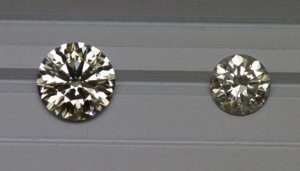jksprincess
Rough_Rock
- Joined
- Aug 11, 2006
- Messages
- 6
Unrelated...I think not!Date: 8/11/2006 6:40:44 PM
Author: Rhino
They recently added metrics for dynamic fire and dynamic contrast which I need to address on that page too.
Peace,
LMAO... Ira I didn''t get it at first then I read my words again.Date: 8/11/2006 6:53:32 PM
Author: Regular Guy
Unrelated...I think not!Date: 8/11/2006 6:40:44 PM
Author: Rhino
They recently added metrics for dynamic fire and dynamic contrast which I need to address on that page too.
Peace,




Whats interesting is ISEE2 has changed the target they cut too and likely the cutters that cut them and they still do very very well on the machine as do the gog specials and other tight stones.Date: 8/12/2006 10:57:44 AM
Author: oldminer
It seems the ISEE2 is engineered to prefer the ISEE2 cut of diamonds sold by the same company that makes the device. It does have some good features anyway, but it is a biased product in some respects. It is worth a look and their diamonds are nicely cut.
Hi Dave,Date: 8/12/2006 10:57:44 AM
Author: oldminer
It seems the ISEE2 is engineered to prefer the ISEE2 cut of diamonds sold by the same company that makes the device. It does have some good features anyway, but it is a biased product in some respects. It is worth a look and their diamonds are nicely cut.

Very interesting. Thanks.Date: 8/13/2006 2:51:05 PM
Author: whatmeworry
Rhino,
Is it your opinion that the 40.6 threshold to get a GIA Excellent cut is primarily based on their observation testing? I ask this because I see no reason for this threshold based on their brilliance and fire computer studies and given the generally wide range allowed to get a GIA Excellent
A few days ago we had a poster ask about a 40.4 pav angle diamond that has a GIA Excellent cut on the grading report, yet if you put in the exact numbers into Facetware it only gets a VG score.
https://www.pricescope.com/community/threads/to-much-education-frustrated-and-at-a-lose-help.49235/
Date: 8/14/2006 11:22:13 AM
Author: allygirl
ISEE2---
There have been m any responses, but many much more technical than I was looking for.
My real thought about this is ....the jeweler explained it as more of a tool to look at the diamond. Yet, I feel that people on these boards are referrring to the diamonds themselves as the ISEE2.
Anyone want to clarify that for me? THANKS!
Good question Serg......Date: 8/14/2006 12:53:18 AM
Author: Serg
Very interesting. Thanks.
What and Where is real GIA cut grading system?
Yes and only with certain angle combo''s coupled with certain total depths.Date: 8/13/2006 2:51:05 PM
Author: whatmeworry
Rhino,
Is it your opinion that the 40.6 threshold to get a GIA Excellent cut is primarily based on their observation testing?
I understand. Just curious ... which brilliance and fire computer study are you referring to? When I first heard of GIA''s allowance for certain steep/deep combinations my hair stood up.I ask this because I see no reason for this threshold based on their brilliance and fire computer studies and given the generally wide range allowed to get a GIA Excellent

Interesting. We recently had a stone in here with 40.4 angles coupled with 35.5 crown angles but got the VG grade. The stone really didn''t look bad at all however with folks purchasing off of paper a GIA VG shuns many anal folks away. I should have photographed this one for reference.A few days ago we had a poster ask about a 40.4 pav angle diamond that has a GIA Excellent cut on the grading report, yet if you put in the exact numbers into Facetware it only gets a VG score.
https://www.pricescope.com/community/threads/to-much-education-frustrated-and-at-a-lose-help.49235/



